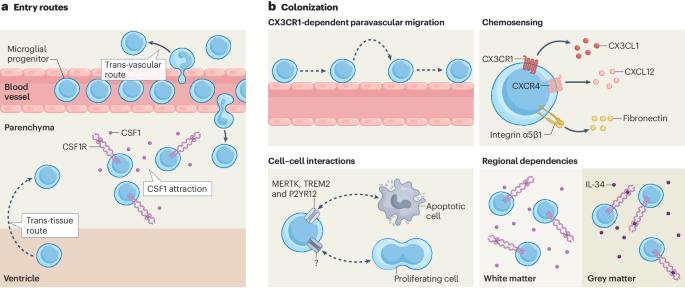小胶质细胞发育动态的分子决定因素
IF 28.7
1区 医学
Q1 NEUROSCIENCES
引用次数: 0
摘要
小胶质细胞是脑实质巨噬细胞的最大群体,由于其胚外起源于卵黄囊,因此被认为是中枢神经系统胶质细胞的一个独特亚群。在发育过程中,小胶质细胞祖细胞很容易增殖并最终定植于整个大脑。在本综述中,我们将重点介绍小胶质细胞祖细胞的起源及其进入大脑的途径,并讨论决定其命运的各种分子和非分子因素,这些因素可能会影响其特定功能。具体而言,我们探讨了最近发现的调控小胶质细胞在大脑中定植的机制,包括空间的可用性,并描述了高度增殖的小胶质细胞祖细胞的扩张如何促进了小胶质细胞龛的占据。最后,我们阐明了在大脑中建立小胶质细胞身份的相关因素。本文章由计算机程序翻译,如有差异,请以英文原文为准。


The molecular determinants of microglial developmental dynamics
Microglia constitute the largest population of parenchymal macrophages in the brain and are considered a unique subset of central nervous system glial cells owing to their extra-embryonic origins in the yolk sac. During development, microglial progenitors readily proliferate and eventually colonize the entire brain. In this Review, we highlight the origins of microglial progenitors and their entry routes into the brain and discuss the various molecular and non-molecular determinants of their fate, which may inform their specific functions. Specifically, we explore recently identified mechanisms that regulate microglial colonization of the brain, including the availability of space, and describe how the expansion of highly proliferative microglial progenitors facilitates the occupation of the microglial niche. Finally, we shed light on the factors involved in establishing microglial identity in the brain. The developmental colonization of the brain by microglial progenitors and establishment of microglial cell identity set the stage for microglial function in the adult. Barry-Carroll and Gomez-Nicola describe the mechanisms that regulate the development of microglia, including their origins, infiltration and colonization of the brain, proliferation and fate determination.
求助全文
通过发布文献求助,成功后即可免费获取论文全文。
去求助
来源期刊

Nature Reviews Neuroscience
NEUROSCIENCES-
自引率
0.60%
发文量
104
期刊介绍:
Nature Reviews Neuroscience is a multidisciplinary journal that covers various fields within neuroscience, aiming to offer a comprehensive understanding of the structure and function of the central nervous system. Advances in molecular, developmental, and cognitive neuroscience, facilitated by powerful experimental techniques and theoretical approaches, have made enduring neurobiological questions more accessible. Nature Reviews Neuroscience serves as a reliable and accessible resource, addressing the breadth and depth of modern neuroscience. It acts as an authoritative and engaging reference for scientists interested in all aspects of neuroscience.
 求助内容:
求助内容: 应助结果提醒方式:
应助结果提醒方式:


